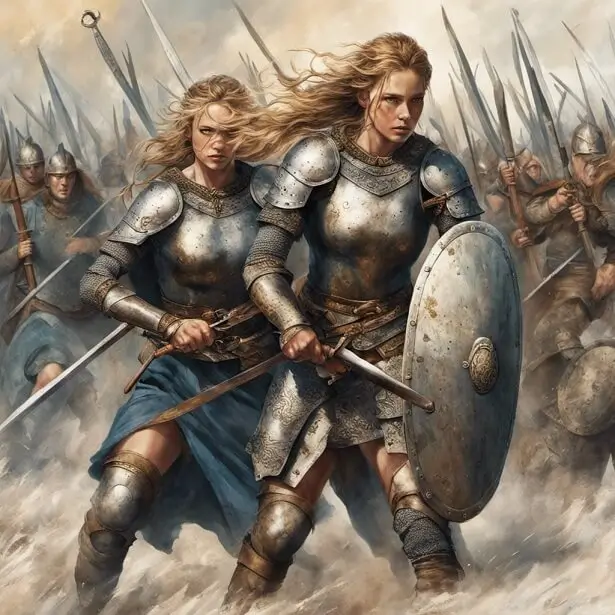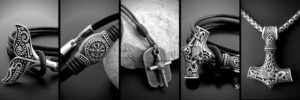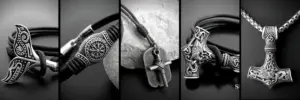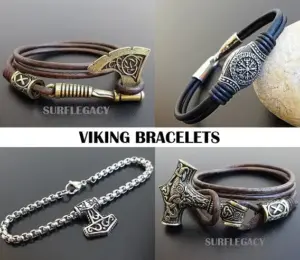Within the veiled corridors of history, the captivating figures of Viking shield maidens emerge. These remarkable women, entrenched in Norse and Germanic tales, disrupted conventions by wielding weapons and standing shoulder to shoulder with men in battles.
While scholarly debates persist about their prevalence, their legacy echoes powerfully. These boundary-breaking warriors defied societal norms, leaving an indelible mark on myths and inspiring imaginations.
Untangling their true stories proves elusive, yet their enduring archetype tantalizingly hints at a world where women showcased valor alongside men, a testament to their unwavering strength and courage.
Who Were the Shield Maidens?
The term “shield maiden” refers specifically to women who took up arms and fought alongside Viking men in battles, raids, and warfare. Known in Old Norse as “skjaldmær” or “skjaldmaer,” these fierce female warriors fearlessly charged into the fray, wielding weapons and donning armor, holding their own against male counterparts.
The image of a Viking shield maiden clad in mail armor, bearing spear and shield as she joins the throngs of warriors, has become iconic over the centuries. Yet separating legend from reality has proven difficult for scholars.
While debate continues over their exact prevalence, some historical accounts do indicate these women warriors were not merely a myth. The Byzantine historian John Skylitzes recorded that women fought among the Viking ranks against the Byzantines in 971 CE. Icelandic sagas also contain tales of shield maidens joining in combat.
Archaeology provides further tantalizing clues. A 10th century grave unearthed in Birka, Sweden contained a female warrior buried with an arsenal of weapons, including sword, axe, arrows, spear, armor, and two horses. An analysis of the remains and artifacts suggests she was a high-ranking officer.

Grave of the female Birka Viking Warrior
Additional graves of women buried with weapons point to the possibility of female warriors being more common than previously assumed. Figurines, jewelry, and illustrations in the Norse style also depict armed women, giving credence to the idea.
The origins of the Viking shield maiden likely lie in earlier cultures. Powerful female warriors feature prominently in ancient Greek, Roman, and Germanic societies. The ferocious Celtic queen Boudicca, who led a uprising against Roman forces in Britain, helped popularize the image of the woman warrior in the minds of medieval scribes and storytellers.
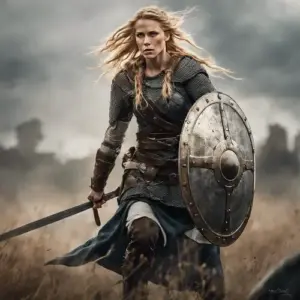
As history gave way to myth and legend, these early accounts morphed into tales of fierce Viking shield maidens fighting with vigor and bravery equal to any man. While gaps remain, the traces these women warriors left behind reveal a society where at least some women took up arms, defying conventional gender roles. Their legacy continues to enthrall and inspire centuries later.
Legendary Shield Maidens
Several shield maidens stand out for their legendary exploits and fearsome reputations. They were said to have fought with courage and skill equal to any male hero.
Brynhildr
The tale of Brynhildr, originating from the Volsunga Saga, illuminates a figure born as a valkyrie but relegated to mortal life. Her transformation into a shield maiden marked a departure from her divine origins, displaying incredible bravery clad in full battle armor. Beyond her tragic end in a fiery suicide, her defiance against fate and patriarchal norms resonates as a symbol of feminine strength and agency.
Lagertha
Lagertha’s chronicle within the Gesta Danorum portrays a woman of exceptional valor and leadership. Her alliance with Ragnar Lothbrok revealed her prowess in battle, notably saving him with a daring maneuver. Post-separation, her ascendancy to queenhood showcases her strategic acumen and military expertise, defending her realm with shrewdness. Lagertha embodies not just martial skill but also the capacity for autonomous rule, challenging gender roles of her time.
Hervor
Hervor’s story from the Hervarar Saga outlines a woman born with an innate martial spirit. Her defiance of gender norms, raiding in male attire, and wielding her father’s cursed sword, Tyrfing, solidify her reputation as a formidable warrior. Despite settling down later in life, her legacy endured through her lineage, contributing to the next generation of shield maidens and highlighting a cultural acceptance of women in martial roles.
These figures, while not as extensively documented as the more famous shield maidens, still contribute to the overarching theme of women’s participation in martial activities within Norse society. Their inclusion in various texts suggests a broader acceptance of women engaging in warfare and challenges stereotypical gender roles prevalent in historical narratives.
Visbur’s Daughters
In the Ynglinga Saga, attributed to Snorri Sturluson, there’s mention of Visbur, a Swedish king, and his daughters who are said to have been skilled in warfare. Although their individual exploits are not extensively detailed, their inclusion in the saga suggests their participation as shield maidens.
Brynhildr of Sweden
Not to be confused with the more famous Brynhildr from the Volsunga Saga, this Brynhildr was a Swedish princess known for her military prowess. Her story is less prevalent in the sagas but still holds significance in shedding light on the existence of warrior women in Norse culture.
Bodvildr
Another figure mentioned in Norse poetry, particularly in the poem “Helgakviða Hundingsbana II,” Bodvildr is described as a woman skilled in battle. Although not explicitly termed a shield maiden, her martial abilities contribute to the broader representation of women engaged in combat.
Others
Thornbjǫrg’s allegiance to King Hrolf in Hrólfs Saga signifies the presence of shield maidens in historical narratives, offering glimpses into their roles in battles and conflicts. Additionally, the accounts of Veborg, Visna, and Hed in Gesta Danorum further illustrate the prevalence and diversity of these warrior women, showcasing their active participation in combat, mirroring the enduring appeal of the shield maiden archetype in Norse folklore and literature.
Is there archaeological proof of shield maidens?
The question of tangible proof of shield maidens is hotly debated among historians and archaeologists. While references in sagas and legends point to their potential existence, the physical evidence remains limited.
Nevertheless, some intriguing clues lend credence to the idea that at least a portion of Viking women took up arms. A number of graves dating from the Viking era contain buried women adorned with weapons and armor rather than typical jewelry or domestic tools.
One of the most stunning discoveries came from the Swedish island of Björkö in the late 1800s. In a boat grave packed with military equipment, including sword, axe, arrows, armor, shields, and two horses, a skeleton was unearthed along with a full set of game pieces.
Analyzed using modern techniques, the remains were definitively identified as female, upending over a century of assumptions. The nature of the elaborate war-like grave goods implies the woman held a high rank, possibly a military commander.
Additional sites around Scandinavia and the British Isles have produced similar female remains buried with daggers, arrows, and other weapons. A grave in Norway contained a female dressed in full armor with a sword and sickle.
Two silver figurines from the era show women on horseback flanked by weapons. The iconic Oseberg burial ship contained deceased female aristocrats and a tapestry with armed women.
While these cases do not definitively prove all Viking women habitually engaged in warfare, they strongly indicate that the role of the shield maiden was not merely the stuff of myth.
Likely, a portion of women in the Viking Age, whether by necessity, choice, or tradition, did indeed take up arms and fight alongside men on occasion. Some may have served as warriors for a period before settling into domestic life.
The rarity of these war-grave discoveries certainly suggests shield maidens were far from the norm. Yet, each new find reinforces the growing view that a small but significant subset of the Viking female population exhibited talents and duties extending beyond the household.
There remain more questions than answers, but the narrative is evolving based on emerging archaeological evidence. The shield maiden, it seems, did exist in some capacity as more than mere legend.
Historical accounts of Viking shield maidens
While archaeological evidence provides vital clues, written historical sources offer another perspective into the potential existence of female Norse warriors. A handful of accounts depict women taking up arms and fighting alongside Viking men.
One of the earliest comes from the chronicler John Skylitzes, who documented the Siege of Dorostolon in 971 CE. During this battle between the Varangians and the Byzantines, Skylitzes wrote that there were many armed women among the Viking dead. He expressed shock at this discovery, providing contemporary validation that some Viking women directly engaged in combat.
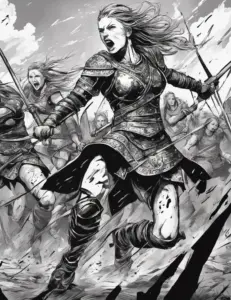
The Danish historian Saxo Grammaticus offers an additional first-hand record from around 750 CE. In his famous work Gesta Danorum, he describes shield maidens fighting for the Danish side under Queen Gambaruk against the Swedes at the Battle of Brávellir.
These women are said to have “the bodies of women and the souls of men,” depicting both their feminine and martial capabilities.
Some Icelandic sagas corroborate this perspective. The Greenland Saga recounts Leif Erikson’s pregnant sister Freydis Eiriksdottir fending off Native American attackers alone by pulling out her sword and thumping her bare chest.
Though not labeled a shield maiden directly, her actions resonate with their attributed bravery.
Later medieval texts also reference Viking women taking part in warfare. The War of the Irish with the Foreigners mentions a “Red Girl” commander leading troops.
Irish annals record shield maidens involved in several battles against the Irish. Thoughsemi-legendary, these sources provide context pointing to the notion of female warriors being rooted in some historical reality during the Viking Age.
While sparse, these written accounts give weight to the view that female warriors held some position, even if small, within the Viking ranks.
Enough eyewitness accounts exist to verify that the notion of the shield maiden had some legitimate basis in the societies and battles waged by the medieval Norse.
Exact numbers remain vague, but their presence was clearly more than mere fancy. The shield maidens, it seems, represented an early instance of women stepping beyond convention into the theater of war.
Shield Maidens vs. Traditional Roles for Women
The lives of most Viking women centered around domestic duties – managing the household, raising children, and overseeing familial matters. Strict gender norms pervaded Norse society, with martial activities and politicking largely relegated to the male domain.
Shield maidens shattered these conventions. By taking up arms and engaging in warfare and raiding, they overturned the expected passive, maternal role of Viking women. Their participation as warriors signaled a more complex and nuanced gender structure within at least some elements of Norse culture.
Several sagas highlight this contrast by juxtaposing shield maidens against more conventional women. The iconic Brynhildr expressed only disdain for the conniving, indirect schemes of her rival, the lady Gudrun. She valued courage and forthright action over feminine guile and deception.
Lagertha too chided women who simply accepted their fortunes and neglected to take an active hand in shaping their own fates, associating such passivity with weakness. Other accounts emphasize the martial talents and leadership acumen of shield maidens compared to common housewives.
These accounts reveal Norse ideals of bravery, honor, and directness in conflict being tied directly to performative masculinity. Shield maidens adopted these masculine-coded attributes and activities, earning masculine-associated titles like “war leader” despite their female sex. Their participation in combat placed them in stark contrast to the majority of women confined to indirect non-military roles.
While most Viking women wove, reared children, and managed households, shield maidens charged ahead with weapons drawn. Their active engagement in masculine spheres flies in the face of modern tropes about rigid gender divisions in medieval Scandinavia.
Though rare, these women reinforce that Viking society allowed at least some room for those who rejected passive femininity in favor of courageous action on and off the battlefield.
What Did Viking Shield Maidens Wear?
The popular image of Viking Shield Maidens often conjures visions of fierce women adorned in battle-ready armor. Yet, historical accounts and archaeological findings offer a more nuanced view.
If these warrior women existed, they likely dressed similarly to male Vikings for battle. Armor, although not as prevalent as depicted in media, might have included a chain mail hauberk over a padded garment, offering protection. Helmets, typically conical and crafted from iron or leather, safeguarded their heads.
Contrary to popular belief, the iconic horned helmets associated with Vikings are more a creation of 19th-century romanticism than historical accuracy. No archaeological evidence supports the idea that Vikings, whether male or female, wore horned helmets in battle.
In combat, Shield Maidens probably wielded weapons akin to those used by Viking men: swords, axes, spears, and shields—integral to their namesake.
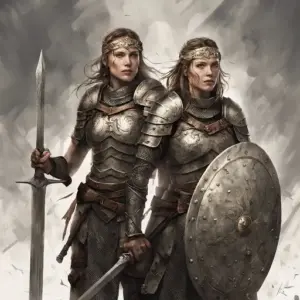
During everyday life, these women likely dressed in typical Viking women’s attire: a linen under-dress beneath a woolen overdress or apron, held together by brooches or chains. Leather shoes or boots were standard, with cloaks or shawls for warmth in colder climates.
Jewelry was common, with brooches, pendants, and beads not just ornamental but also carrying symbolic and protective significance.
While it’s tempting to imagine Shield Maidens in constant battle gear, they were integral parts of their society, leading multifaceted lives that required diverse roles and attire.
Valkyries
In Norse mythology, valkyries hold a special position as female figures closely aligned with combat and the fate of fallen warriors. Their attributes and duties bear striking parallels to the shield maidens of Viking legend.
Valkyries were tasked with selecting heroes who died bravely in battle and guiding their souls to Valhalla, Odin’s majestic hall where they would continue training and feasting until the apocalyptic battle of Ragnarok. This role placed valkyries at the very heart of Viking warrior culture and rituals around death.
To fulfill this solemn responsibility, valkyries needed intelligence, martial skill, and familiarity with combat. They also exhibited courage, cunning, and leadership in mediating between the realms of the living and the dead. The qualities matched perfectly with those attributed to shield maidens through tales of their battlefield exploits.
It is likely more than coincidence that these two types of female figures share so many traits. Many scholars believe the concept of the valkyrie emerged from earlier oral and written stories of shield maidens displaying valor and honor when fighting alongside men. Over time, these mortal women became mythologized as semi-divine choosers of the glorious dead.
This link between valkyries and shield maidens resonates with traces of the latter found in artifacts, graves, and historical accounts. It insinuates that the valkyries of Norse myth stem at least partially from a kernel of reality about Scandinavian women who were expected to hold their own in martial settings and display the courage and spirit of any immortal hero.
In this light, valkyries can be viewed both as mythical counterparts to shield maidens and also as acknowledgements that women were felt capable of participating in war and shaping its outcome. Their evolution speaks to the cultural significance and symbolic power these female warriors held in the Viking milieu.
Modern Pop Culture Depictions
The iconic shield maiden continues to be a staple of popular media, reimagined through modern storytelling for contemporary audiences. Though debated, their symbolic status as female warriors empowers present-day narratives.
The History Channel drama Vikings brought Lagertha, legendary shield maiden and onetime wife of Ragnar Lothbrok, back to life. Played by Katheryn Winnick, Lagertha is considered the greatest shield maiden of her era – a fierce fighter who leads armies and rules as a Jarl in her own right. Her character drives home female empowerment themes that resonate with viewers.
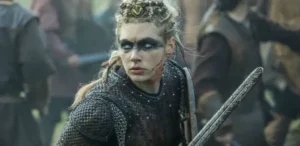
Lagertha from Vikings
The Norse-inspired fantasy series The Last Kingdom features fictional shield maiden Brida. She embodies the war-born independence and battlefield prowess associated with these icons. Other shows like Beforeigners weave shield maidens into crime dramas as strong female leads.
Ubisoft tapped into the appeal with 2020’s video game Assassin’s Creed Valhalla, letting players embody Eivor the Wolf-Kissed, a Viking raider whose badassery channels the shield maiden ethos. Eivor proves women can be equally imposing warriors and leaders compared to male counterparts.
Shield maidens have inspired fictional warrior women figures since Tolkien’s Eowyn. Fantasy novels like Nancy Farmer’s Sea of Trolls trilogy feature battle-hardened heroines Thorgil and Jack, while Morgan Rice’s Viking-themed Vows and Honor series emphasizes fierce sisterhood in arms.
Comic books and manga have also adopted the theme. Vinland Saga focuses on the exploits of the shield maiden Thorfinn in medieval Europe. Avengers of the Moon spotlights Marvel’s take in the character of Astra, drawing direct inspiration from Norse legends.
These renditions may embellish history, yet they highlight ongoing fascination with these icons of female power. The valiant spirit of the shield maiden still resonates in modern narratives celebrating women’s strength, from comics to video games to action-packed dramas. Their symbolic legacy persists as entertainment evolves.
Key Takeaways
- Shield maidens were women warriors in Norse and Germanic tales who fought alongside men, wielding weapons and armor.
- Historical accounts and archaeological evidence suggests some Viking women did take up arms, defying gender roles.
- Famous shield maidens like Brynhildr, Lagertha, and Hervor were said to match male heroes in valor and skill.
- Graves of armed women point to a subset of female Vikings directly engaged in combat or military leadership roles.
- Accounts depict shield maidens fighting in battles, showing they had some grounding in Viking society.
- Qualities of mythic valkyries likely emerged from oral tales of real shield maidens displaying courage.
- Their legacy as female fighters empowers modern pop culture depictions in shows, games, books, and comics.
Shield Maidens – FAQs
How many female Viking warrior graves have been found?
Only a small number, around 26, have been definitively identified. This indicates shield maidens were relatively uncommon, though new DNA analysis techniques may uncover more.
Did shield maidens fight alongside the men in regular battles?
Accounts are limited, but sources mention shield maidens fighting in some battles. They likely participated alongside men on occasion but were not part of the normal ranks.
Did shield maidens only exist early in the Viking Age?
References appear up through the 13th century, indicating they persisted in some capacity throughout the Viking era. But they were likely most common during the early Viking raids.
Could a shield maiden also marry and have a family?
Yes, shield maidens may have fought when young and unmarried before settling down. Some accounts mention shield maidens who did marry and have children after their fighting days. Their active warrior lifestyle was temporary for many.
Is Freya a Shield Maiden?
While Freya isn’t classified as a traditional Shield Maiden, her role in Norse mythology extends beyond mere associations with love and beauty.
She influences warfare, choosing fallen warriors for her heavenly hall and possesses powerful artifacts like the Brisingamen necklace.
Known for her strength and independence, she practices seidr, a sorcery linked to war. While not a literal Shield Maiden, Freya embodies a potent, multifaceted figure, blending attributes of power, war, and goddess-like qualities in Norse mythology.
Conclusion
The captivating legend of the Viking shield maiden has endured for centuries, capturing imaginations with tales of fierce women warriors joining the ranks of men in battle.
While debates continue over their full prevalence in history, the traces these brave figures left behind hint at a society where at least some women transcended conventional gender boundaries.
Their larger-than-life legacy lives on as a powerful symbol of martial courage and strength that still inspires modern depictions. Though the realities prove hazy, the shield maiden archetype remains influential, bringing these trailblazing women of the Viking Age vividly to life in myths, narratives, and the popular consciousness.
Shop Viking Jewelry
Are passionate about Vikings or Norse Mythology?
Finding the ideal piece of Viking Jewelry can be challenging and time-consuming, especially if you lack inspiration or don’t know where to look.
Surflegacy, has you covered. We have a wide range of Handmade Jewelry in various styles, shapes, colors, and materials, to accentuate your Viking spirit and look. Do not hesitate to visit our selection HERE

